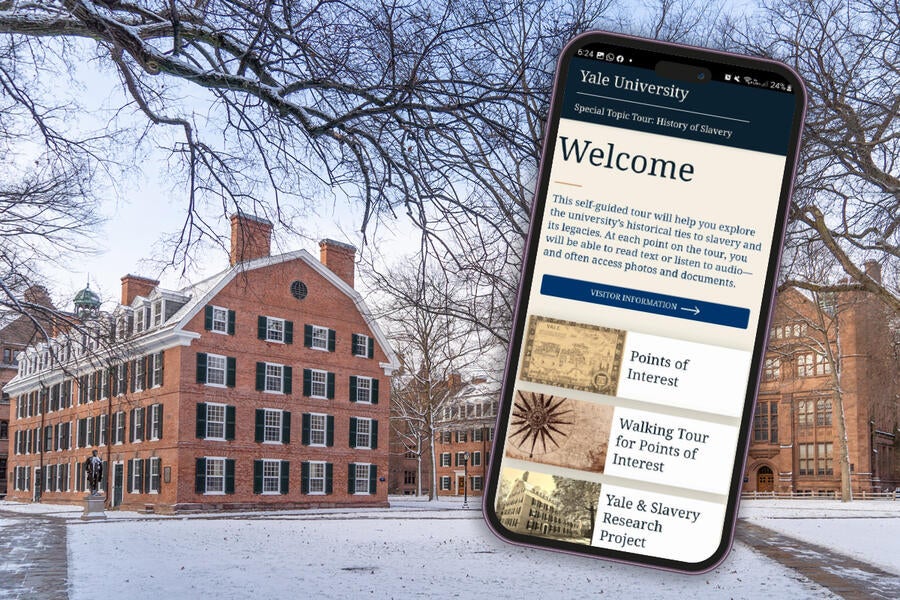
Connecticut Hall, the oldest building on Yale’s campus, exemplifies colonial architecture. It is the only surviving building from the Old Brick Row (circa 1750-1752), which was the first linear campus plan in the United States and a template for American college campuses built in the 19th century.
It is also a stop on the new self-guided walking tour app that the university debuted on February 16, along with Yale and Slavery: A History and an exhibition in the New Haven Museum. The project is a culmination of the efforts of the Yale and Slavery Working Group, convened in October 2020 by President Peter Salovey and led by David Blight, Sterling Professor of History, of African American Studies, and of American Studies and director of the Gilder Lehrman Center.
Take the tour now: The Yale University Special Topic Tour: History of Slavery can be downloaded to any smart phone.
The app guides participants on a campus tour consisting of 19 sites, each of which is connected to the history of slavery at Yale. At each point on the tour, one can read text, listen to audio, and access photos and documents. The narration is performed by Michael Allyn Crawford and Whitney Andrews, students in the David Geffen School of Drama. In the case of Connecticut Hall, the records of Yale President Thomas Clap indicate that at least five enslaved men contributed to the building of the historic structure, including one who was enslaved to President Clap.
Although the written and digital contents of the app were developed by teams across Yale, the app itself is the creation of a team of IT staff members led by Netal Petal, a custom applications development manager at Yale Information Technology.
When embarking on their task, Patel and her team took to heart the somber significance of this project for the university and the weight of the content. “The subject of the app is very important for addressing Yale’s history with slavery,” said Kim Loveland, business systems analyst. “We think the app is a good counterpart to the rest of the Yale and Slavery Research Project, to have people walking around and physically connecting to the history and what the app is trying to teach,” she said.
A creative process
Developing an app, no matter the subject, is a creative process. Loveland likened it to making a movie where you start with an idea and a script. “Once a script from the client is in hand, you study the requirements for the project,” she said. “You need a director, like Netal; actors, our experienced team; and a set, the mobile app. Everybody has a part to play, bringing their expertise to the table. All the elements come together and we ‘screen the movie’ in the testing phase, to make sure that the end-product is what we and the client envisioned.”
In addition to Patel and Loveland, the IT team included Javier Noriega, project manager; Jesús Uresti Rangel, technical lead; Nestor Rodriguez Ayala, software engineer; Sneha Bhat, software engineer; Grecia Briseno, UX designer; Enrique Perez and Abimael Jaimes, both quality assurance testers.
Uresti noted, “We chose the technology that fit best given the requirements, and based on our choice, selected the experts who know the chosen technology. We needed to find the right developers with the right skills.”
Confronting the past, one swipe at a time
Patel said that once the requirements were met during development with Rodriguez Ayala and Bhat, the app was designed with a focus on user-experience. “We worked very closely with the user interface and user experience team when we designed the screens—in this case with Grecia Briseno,” said Patel.
The quality-assurance testing took place next, led by Perez and Jaimes. “Functional testing and accessibility testing were done followed by user-acceptance testing, working with the working group—all to make sure that the product met the end-user needs,” said Patel.
“We want the users’ experiences to be smooth,” said Loveland. “It must be obvious to them right away what they should be doing—where to press, swipe, or scroll to get to the content that the client and the developers want them to experience.”
The team did not take lightly their charge to convey the complexity and the gravity of the subject matter to the end user. Said Noriega, “When I started reviewing the text, the audios, the pictures, just everything that we worked with to create this app, I was amazed at the amount of responsibility Yale is taking; how Yale wants to confront this issue of the past and show it to the world, so it does not happen again. I am really proud of being able to work on this project to help Yale take action.”
“I’ve worked on other educational applications before, but this one is special,” said Rodriguez Ayala. “I learned a lot from being on this very multi-cultural team, and a lot about the history of slavery at Yale. These topics were new to me, and the app is a great way to allow other people to know about them. I feel especially proud that I’m able to provide users with new information to help them understand new things.”
To learn more about the university’s actions, commitments, and response to date, please visit the Yale and Slavery Research Project’s website.
Yale and Slavery: A History, by David W. Blight with the Yale and Slavery Research Project, was published by Yale University Press. This narrative history is a comprehensive examination of how slavery and resistance to it have shaped this university. You can order the book or download a digital version for free on the Yale and Slavery Research Project’s website.
The exhibition at the New Haven Museum runs through summer 2024 and there is no charge for admission.


